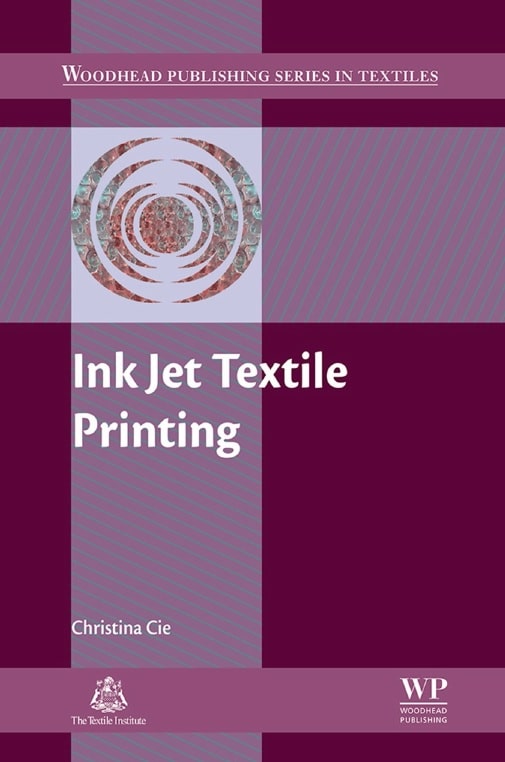
Contents
Woodhead Publishing Series in Textiles ix
Preface xvii
1 Theoretical foundations for ink jet technology 1
1.1 Introduction 2
1.2 Hydrodynamics 3
1.3 Elasticity 3
1.4 Viscosity 4
1.5 Electricity 5
1.6 Surface tension 7
1.7 The “founders” of ink jet technology 8
1.8 The first ink jet printer 9
1.9 Conclusion 9
References 10
2 The development of ink jet printing on textiles 15
2.1 Introduction 16
2.2 The first ink jet printer 16
2.3 The emergence of ink jet printing 17
2.4 Carpet: the first ink jet printer on textiles 20
2.5 Fabric: the next ink jet printer 21
2.6 Conclusion 24
References 24
3 Cloth as a substrate for ink jet printing 29
3.1 Introduction 30
3.2 The production of printed textiles 30
3.3 Textile handling 33
3.4 Ink as a consumable 35
3.5 Direct to garment 36
3.6 Printing on carpet 38
3.7 Printing on fabric 39
3.8 The business of printers and textiles 40
3.9 Conclusion 41
References 41
4 Color management in ink jet printing 43
4.1 Introduction 44
4.2 The perception of color 44
4.3 The production of color 44
4.4 Defining color 46
4.5 Workflow for the design, print, and sale of printed textiles 48
4.6 Calibration 50
4.7 Color print production 51
4.8 Conclusion 56
References 57
5 Pretreatment for ink jet printing 59
5.1 Introduction 60
5.2 Pretreatment application 60
5.3 Pretreatment ingredients 61
5.4 Research for pretreatment 63
5.5 Prepared for print fabrics 65
5.6 Pretreatment, postprint treatment, and pollution 66
5.7 Conclusion 68
References 69
6 Ink jet print heads 73
6.1 Introduction 74
6.2 Drop formation and delivery 74
6.3 Print head architecture 75
6.4 Print head types: ink drop formation 76
6.5 Print head types: ink jet delivery 78
6.6 Print head array and passes 79
6.7 Print heads and inks 80
6.8 Print head problems and maintenance 81
6.9 Conclusion 82
References 83
7 Inks for digital printing 85
7.1 Introduction 86
7.2 Ink types 86
7.3 Ingredients for inks 88
7.4 Ink formulation 90
7.5 Image quality 91
7.6 The missing inks 93
7.7 The business of ink 94
7.8 Conclusion 95
References 95
8 Fixing ink jet printed textiles 99
8.1 Introduction 100
8.2 Fixing 100
8.3 Methods for fixing 101
8.4 Durability 104
8.5 Archiving 106
8.6 Preservation 107
8.7 Copyright 108
8.8 Conclusion 108
References 109
9 Washing ink jet printed textiles 111
9.1 Introduction 112
9.2 Washing 112
9.3 Water and washing in printing on textiles 113
9.4 Effluent 116
9.5 The consequences of washing 117
9.6 Print engineering 118
9.7 Conclusion 121
References 121
10 Heat transfer and sublimation printing 125
10.1 Introduction 126
10.2 History 126
10.3 Market sector 129
10.4 Preparation for printing 130
10.5 Ink 131
10.6 Transfers 132
10.7 Printing 132
10.8 Postprint finishing 133
10.9 Environmental impacts 134
10.10 Conclusion 135
References 135
11 The effect of ink jet on the textile printing industry 139
11.1 Introduction 140
11.2 The business of printed textiles 140
11.3 Printers 143
11.4 Wholesalers 144
11.5 The “service bureau” 145
11.6 Retail 147
11.7 Conclusion 151
References 151
12 The effect of ink jet printing on design for the textile industry 153
12.1 Introduction 154
12.2 The business of textile design 154
12.3 Fashion designer 157
12.4 Design for homeware 158
12.5 Costume designer 159
12.6 Textile designer 161
12.7 Conclusion 163
References 163
13 Further opportunities with ink jet printed textiles 165
13.1 Introduction 166
13.2 Printing 166
13.3 Production 170
13.4 Purchase 172
13.5 Planet 174
13.6 Conclusion 174
References 175
Index 179
